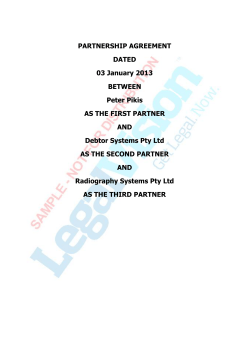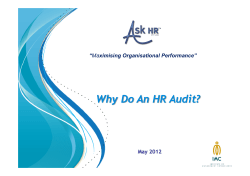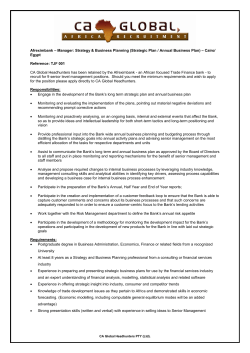
No Technology Silver Bullets your investment Be Different:
Be Different: Learn from the Leaders No Technology Silver Bullets – How to get the most out of your investment Learn from the Leaders: No Technology Silver Bullets – How to get the most out of your investment Contents If only it was as easy as the vendors say........................................................... 3 The Problem May Be Harder or Different Than The Vendor Will Admit ............ 4 Is there an answer?............................................................................................. 5 Conclusion........................................................................................................... 6 2 Copyright 2011 - Limebridge Australia Pty. Ltd. Proprietary and Confidential If only it was as easy as the vendors say In the customer service and sales areas, technology vendors have been parading their array of silver bullets for many years. “Workflow software”, then “CRM solutions”, “quality management products”. “Speech recognition” and “Skill based routing” are among those touted as the “best things since sliced bread” (a product also less in demand today). However, time and again companies have been disappointed with the results they have obtained. Of course little is written about this as the vendors certainly won’t admit it and senior executive sponsors won’t confess disappointing results. But the problems are there with examples such as: •The major bank who re-implemented their CRM application three times across their branch and call centre network before they got the levels of lead generation they wanted •The financial services company that locked in the expected benefits of call recording and CTI routing technologies only to find that expected benefits didn’t result and leaving the contact centre undermanned •The company who found that workflow software delivered only minor benefits without major process and behavioural change programs •The Telco whose new speech recognition and intelligent routing systems reported it’s own routing success but failed to measure the cost in additional transfers and on the end to end experience of the customer So why don’t these apparent silver bullets work and what is needed to unlock the theoretical benefits of these solutions. There are companies who have managed to get benefits from some of these technologies “after the fact” by looking at their business in a more holistic way both for the organisation and customer. The results from those who applied the solution are in stark contrast to the growing list of technology driven failures that litter the corporate world. Copyright 2011 - Limebridge Australia Pty. Ltd. Proprietary and Confidential 3 The Problem May Be Harder or Different Than The Vendor Will Admit Many of these failures share some common characteristics which also help identify what is really required. We’ve isolated four key drivers 1. Lack of focus on the customer and the experience 2. Incomplete understanding or the problem or business issue 3. Incomplete scope of solution 4. Poor design Taking each in turn and as symptoms you can look out for: Lack of focus on the customer Poorly defined IVR, speech and routing technologies are often a result of an over emphasis on “what we need from the customer” or “the way we want to organise” rather than thinking through the experience the customer wants and its implications for organisation and process design. So companies who create complex speech or prompt based routing menus in order to create complex and detailed “skilling models” seem to have last touch with the customer goal which is to get to someone who can help as soon as possible with the least navigation possible. What is even more alarming is that the complex skill based models also fly in the face of broader corporate strategies such as having a “whole view of customer” or increasing share of wallet. They also create complexity that becomes harder to manage. Scheduling and rostering across 30 roles is far more complex than a lower number and some of the other tools and technologies such as rostering and workforce planning become almost unworkable at this level of complexity. Incomplete business understanding: customers don’t understand complexity Many of the menu, speech and routing models are trying to address issues of complexity. They recognise that it is too hard to train staff to deal with all products and services. They therefore attempt to isolate the customers need to a given product or service. Unfortunately this doesn’t isolate complexity. A customer can recognise they have a billing problem but they can vary from the simple (when’s my next bill due) to the complex (“my bill is wrong”). So using product and process isolation often fails to create the simplified roles that the company was striving for. Incomplete scope and disappointing value delivery Technology solutions are often an enabler of change rather than the answer. For example quality software can enforce poorly defined processes and knowledge management solution can document overly complex processes or products. But both those technologies also require major behaviour change to be effective. A call recording or quality measurement tool requires intelligent use by team leaders and coaches if it is to make any difference to behaviour and performance. Similarly a well populated knowledge tool destroys value until it is used by staff to deliver the right answers or answers more quickly. 4 Copyright 2011 - Limebridge Australia Pty. Ltd. Proprietary and Confidential Too often failed technology projects fail to recognise that they only deliver value when they bring about significant changes in behaviour. Self service technology like web sites needs to change end customer behaviour and call quality and knowledge management solutions need to bring about significant changes in staff behaviour. Recognition of this leads to a much broader scope for these projects. Often that doesn’t happen because the payback looks worse when the full scope is recognised. But isn’t it better to understand what is really required, to evaluate alternatives and scope what is need rather than invest in solutions that don’t deliver? Poor design Even if the idea behind a technology has merit and broader business issues are considered, the solution design may still undermine the value a company gets from it. So an overly complex menu, a plethora of skill sets or a poorly defined quality process may all undermine the potential of those solutions. Poor usability in any application designed for customers will either put them off using it or make their use ineffective. But the corporate world is littered with failures like speech applications asking open ended questions that the technology can’t cope with or knowledge tools that are in themselves so hard to navigate that the knowledge is almost inaccessible to someone dealing with a customer. So the design needs to be right whatever the solution. Is there an answer? The answer we have found is to not to start with a technology in mind but to work in one of two ways using a broader business framework that we call the PRISM model of effective operations. This model has helped organisations get effective value from their technologies in one of two ways: 1.Get the business value from technologies they have already implemented 2.Scope and select the appropriate business change, including technology for problems they are trying to solve. The PRISM methodology gets companies to look at their operations through five “interdependent” dimensions namely - the Practices or processes they have in place - the Resourcing model they use to implement these practices - the Incentives and indicators that enforce and fine tune the execution - the Structure of the organisation required to handle customer needs - the Management processes needed to make the operations effective. This model has been used to get more value from existing technologies, to question the need for additional technologies and to identify the most appropriate technologies. Three examples explain how it has been used: Unlocking the process impact of technology A company had implemented call recording and quality assurance software. While the solution was useful to bring to life coaching sessions and helped locate problem and disputed calls these benefits were minor in comparison to the cost. But by looking in depth at the practices, incentives and management processes (three PRISM dimensions) the company unlocked an even bigger prize. The company hadn’t noticed that staff used a practice of recording detailed notes about every interaction. As we Copyright 2011 - Limebridge Australia Pty. Ltd. Proprietary and Confidential 5 observed the practice we found it odd that agents rarely reviewed these notes on repeat calls and that in the case of disputes they were ignored. However, the quality process and measurement regime re-inforced that notes were needed on every call. In fact the quality solution meant that notes were often no longer needed. By re-thinking the practice and aligning measures and management, we were able to reduce the pointless “note taking” on 80% of calls freeing up staff time and removing a practice that staff disliked. That was just one way that PRISM unlocked more benefits from the technology solution. Unwinding the complexity of routing A major financial services company had implemented a complex skilling model supported by a complex IVR and sophisticated routing software. However, other problems has crept into the “system” that hadn’t been recognised. For example, customers often got their IVR selections wrong so over 20% of calls were transferred which was hidden waste in the system and a poor experience. Furthermore, team leaders couldn’t get a clear picture on staff performance because staff had a range of skills and were swapped in and out of these skills by a central control group depending on call volumes. This made it hard to coach or improve performance. Applying the PRISM framework delivered a different structure of skills layered around complexity rather than products or processes. This was supported with practices, incentives and measures to make it effective and in doing so the IVR was delayered and made simpler. Unplanned transfers were reduced to almost nothing and performance visibility changed dramatically. Again the promise of the technology was unlocked by a more holistic solution and the company freed up over 20% of their resources and customers spent less time in the IVR. Using process and structure do obviate the need for complex knowledge solutions A wealth management company was contemplating investment in knowledge tools and software. They had despaired at how hard it was for their front line staff to learn the myriad of products and processes and navigate through the complex regulations. However, looking at the problem through PRISM found that different structures and processes could isolate the need for complex knowledge to a much smaller group of experts. All that was really required was a well defined set of practices stored on line and easily accessed and management and measurement to back these up. The results were revolutionary with over 25% workload reduction across the operations and no technology investment required. Conclusion It is possible to get benefits from technology but typically not without considering a much broader set of solutions such as the PRISM model. That may also make you consider if technology is really the answer and may often identify that it isn’t. 6 Copyright 2011 - Limebridge Australia Pty. Ltd. Proprietary and Confidential Victoria L27 101 Collins Street Melbourne Vic 3000 T +61 3 9499 3550 E info@limebridge.com.au Western Australia L18, Central Park 152-158 St Georges Terrace Perth WA 6000 T +61 8 6311 4699 E info@limebridge.com.au New South Wales L57 MLC Centre, 19-29 Martin Place Sydney NSW 2000 T +61 2 9238 6265 E info@limebridge.com.au www.limebridge.com.au Copyright 2011 - Limebridge Australia Pty. Ltd. Proprietary and Confidential 7
© Copyright 2025





















